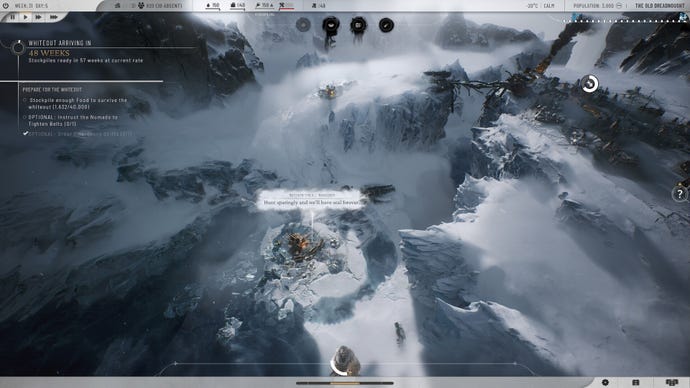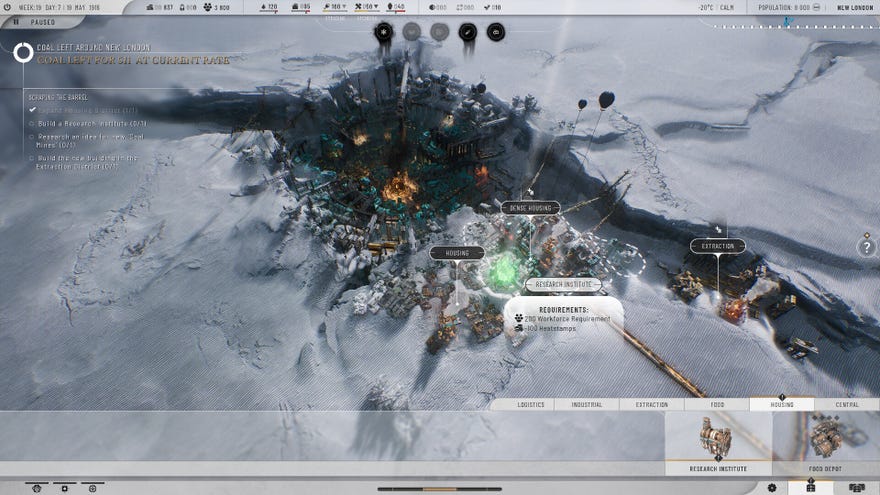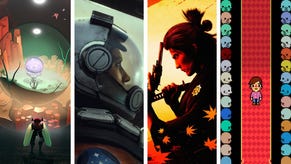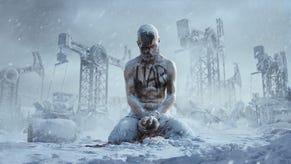Frostpunk 2 will live or die by its faction voting mechanic, and the biggest faction of all is Twitch
A chat with 11 bit about integrating the game's council hall with social media
To kick off with some extremely half-arsed mytho-geometry, the original Frostpunk was a testament to both the design utility and the inexhaustible political symbolism of circles. When people wish to found a community of equals they commonly form a circle, with each participant visible and audible to the rest. A circle is also the best shape for defending against an engulfing ambient threat such as a global ice age, because it has no weak points, and it makes a great centrepiece for a videogame interface, a symmetrical motif that can be tuned and adorned to either suck your attention into the screen or distribute it evenly in all directions.
Created by Polish developers 11 bit, Frostpunk takes place in the middle of a circle, an Arctic crater with a huge coal generator at its heart. Your city rises in rings around that generator, each additional layer of dwellings corresponding intuitively to decreasing temperature, and the result is one of the most focused and thematically consistent specimens of its genre - a building game that feels as intimate and urgent as tending a campfire. Frostpunk 2's new campaign mode breaks the circle open. It starts where you (hopefully) ended, with the crater now fully colonised and evolved into a glaring, blue-orange geode of high-density housing and clustered chimneys. But the view has been pulled back, and construction now unfolds along the plains and canyons beyond the crater, which consist not of circles but of hexagons - another UI designer's favourite - on which you'll plot out upgradeable districts rather than assembling individual buildings.
It's an expansion of the premise that is as plausible as it is dissatisfying, for this returning player. The "last city" has weathered its first winter, outgrown the huddled defensive cosiness of the circle, and the result is a more dispersed, detached and divided simulation in which citizens (and citizen deaths) are counted by the hundred rather than the dozen, and individuals can no longer be followed from dwelling to worksite. Still, the circle persists to a degree in Frostpunk 2. Greater geographical scale aside, the game's headline new feature is a grand council chamber where rival factions of frostpunkers form rings and bicker endlessly over draconian or... less draconian laws that determine the adoption of potentially city-saving technologies, such as coal dust reclamation.
The factions range from Faithkeepers, who have all but deified the original game's Captain, through Frostlanders, who favour survivalist lifestyles with a generous dash of eugenics, to Machinists who, naturally, want to solve every problem using pipes and gears, whatever the fallout in terms of pollution. You'll need to satisfy the majority of those squabbling parties as Steward - the first council vote in the game is whether you should keep your job - which may involve allowing one group to choose the next vote, or trying to pit that faction's moderates against the zealots.
Matt Cox has already gone long on how all this handles based on beta playtime, concluding that Frostpunk 2 "takes one big step away from granular survival and one giant leap towards societal cohesion-weaving" and that "I started having much more fun once I stopped lamenting that loss". I'm still lamenting the loss, myself, after an hour with the new campaign at an 11 bit event last week. I miss the frail circle of firelight that was the original game. But I'm eager to get to grips with the wheeling and dealing of that council chamber, nonetheless - and there's at least one potentially transformative element: Twitch integration. In Frostpunk 2, streamers will be able to let their viewers vote as part of the council, extending the game's exploration of factionalism into the wilds of social media.
The Twitch integration is more "central and meaningful" than you'd find in games like Baldur's Gate 3, co-game director and design director Jakub Stokalski tells me, because the game is already something of a collection of studies of old and new social systems. "We always try to construct our worlds and what we represent in them by making them as relatable as possible - they are speaking to some truth at some level, right?" he explains. "So we try to research pretty much anything we put in our games, and our societies, communities and factions that we have [in Frostpunk 2] are no different. We spent a good deal of time researching very different communities, very different groups of people, very different nations, cultures, all across history, basically, to see how the environment, how their interactions can shape them into cultures that value very different things."
Letting viewers vote as part of your council is a tacit continuation of this research into the networked digital age. "Frostpunk is a game about you trying to lead a city and a group of people out of tight spots, and navigate the challenges of the game," Stokalski goes on. "And if you think about it, Twitch integration is almost like making an MMO without an MMO, right? This is very much what's happening in the game, with the voting, and maybe if we manage to squeeze in a couple of other features for the Twitch integration... if you play with that, it's like taking on 'more mass' to your society, really. And maybe it's even more relatable, because it's real people voting for real things."

“Real people voting for real things” covers a lot of ground, here. Some of the inspirations for Frostpunk 2’s factions go back decades or centuries: there are factions that recall popular caricatures of Sparta, and your citizens are still broadly the fugitive descendants of the British Empire at its height. Other, broader influences on the game's political and social mechanics are ongoing - they're happening a few hours away in Ukraine. "Obviously, it was interesting making Frostpunk in the era when climate change was [becoming widely discussed]," Stokalski says. "But right now, Frostpunk 2 is relevant for a slightly different set of themes. It's these themes of internal conflict, right? And how terrible groups of people can be to each other, if they focus on seeing ideas, rather than people. Honestly speaking, it was sometimes terrible making this game and just reading the news, you know, with the war just over the border, or with the things that are happening now in the Middle East, and basically, the whole world starting to boil."
Stokalski isn’t a Twitch “power user” himself, and doesn’t have much to say about the cultural dynamics of Twitch beyond some more general observations about how people behave when they’re permitted to be anonymous. But he’s fascinated to explore how Twitch chat participants react to being enlisted as Frostpunk council members - and so am I, with a fair amount of caution. Twitch integration might be an opportunity for creative audience roleplay in the hands of streamers with a gift for participatory storytelling – I can imagine viewers having fun devising their own Frostpunk factions and who knows, having some useful conversations about those wider themes and parallels. That’s the optimistic prognosis, of course: I can also imagine a lot of trolling and guerrilla messaging from viewers who find, say, the cull-the-weak creed of the Frostlanders more relatable than they should. Either way, it’s not a set of interactions you can easily describe with a circle.










